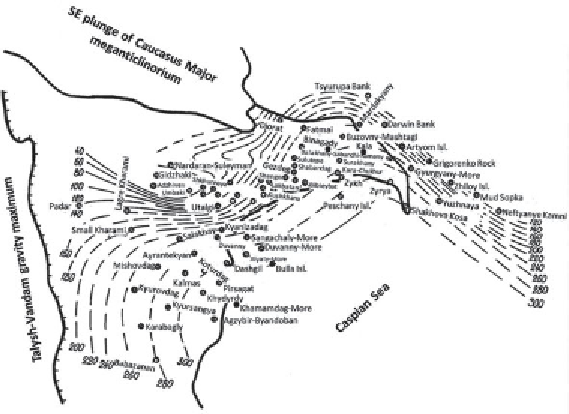Geology Reference
In-Depth Information
Figure 2.2
South Caspian Depression (west flank). Schematic map of the Maikopian Fm.
(Oligocene-Lower Miocene) total ground water salinity.
exceed 0.5 mg-equiv. The calcium and magnesium contents vary between
0.1 and 5 mg-equiv., and the sodium and potassium contents, between 16
and 70 mg-equiv. The primary alkalinity factor is 6-35%-equiv., and the
secondary salinity factor is 2-7%-equiv. It is noteworthy that commercial
oil reserves are in contact with the waters of rather high (about 20-35%-
equiv.) primary alkalinity (Umbaki, Karadagh fields), whereas together
with noncommercial saturation come much lower values of this parameter
(up to 10%-equiv. - Ragim prospect).
On the whole, a trend is recorded of the Chokrackian horizon water
salinity increase toward the general regional dip. This mostly corresponds
with its decreased deformation in the same direction.
Waters
of the Diatomaceous formation
(Upper Miocene) belong to the
chlorine-magnesium, chlorine-calcium and hydrocarbonate-sodium types.
The sulphate-sodium varieties are encountered sporadically and mostly in
the surficial reservoir exposure areas. The same as with the aforementioned
stratigraphic intervals, the hydrocarbonate-sodium waters are usually
associated with fault zones, mud volcano development areas and diapirs.
They are usually connected with hydrocarbons, whereas chlorine-calcium
and chlorine-magnesium varieties are mostly typical of nonproductive
traps, which are much weaker deformed, and of some non-oil-saturated
fault-blocks.

